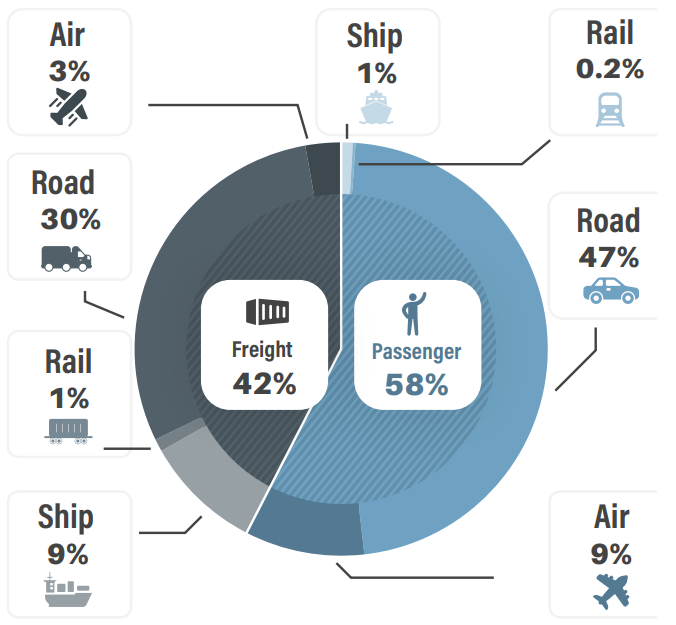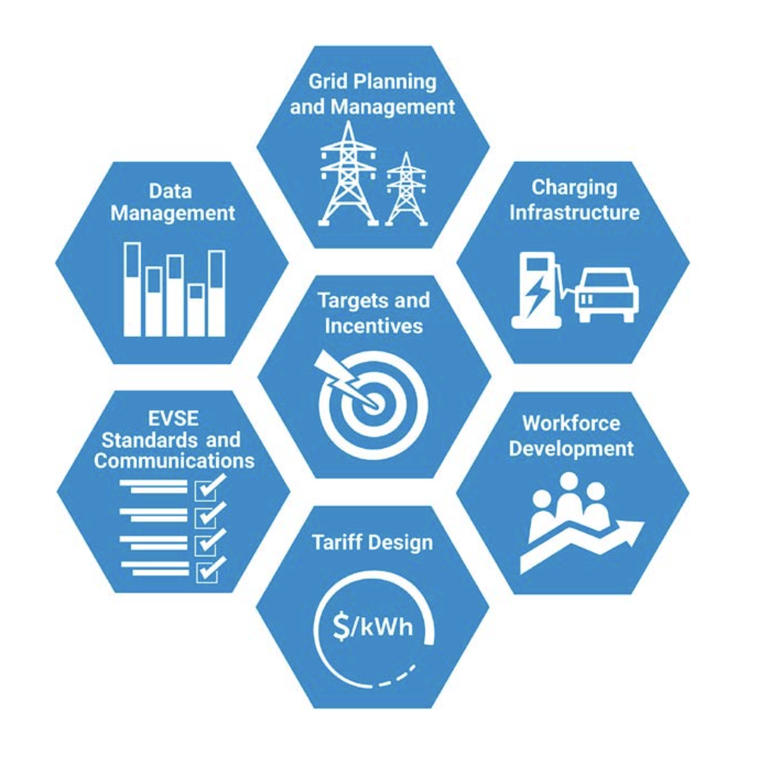Technical Themes and Resources
With the transport sector accounting for 8.8 Gt of CO2 emissions globally, as shown in Figure 1, the transition towards sustainable transport and electric mobility is crucial for combating climate change, energy security and independence, improving air quality, and generating new jobs and green economies. This section examines various international approaches to sustainable transport, featuring resources from regions such as Asia, Africa, Latin America, the Caribbean, and the Middle East. By understanding regional and local challenges and opportunities, policymakers, technical leads, and country partners can develop effective, tailored solutions for sustainable transport deployment.
Figure 1: Transportation Sector Global CO2 Emissions by Activity and Mode (SLOCAT Transport Pathways to Reach Global Climate and Sustainability Goals).

The USAID-NREL EV building blocks outline key components essential for a safe, economical, sustainable, and efficient transition to an electrified transport sector. These components cover technical, institutional, and economic aspects to ensure a well-rounded approach to advancing electric mobility. They include:
-
Targets and Incentives for EVs and EV Charging Infrastructure Deployment: Implementing a range of complementary policy options is critical to catalyze a robust EV market.
-
Data Management for EV Deployment: Effective data curation and management help identify the potential benefits of vehicle electrification and enable the design of targeted strategies to scale EV deployment.
-
Establishing a Network of Charging Infrastructure: The development of the EV market relies on the availability of charging infrastructure. This can be achieved through various ownership and investment models, balancing public and private sector resources to meet diverse charging needs and locations.
-
Standards and Communications Protocols for EV Charging Infrastructure: Establishing and enforcing a regulatory framework for charging standards, equipment certification, and installation codes ensures a compatible, reliable, and safe operating environment for EVs.
-
Grid Planning and Management: The introduction of new EV loads on the electric grid presents both challenges and opportunities. Long-term preparation and planning by utilities can ensure that EVs make the grid more robust and resilient instead of less.
-
Electricity Tariff Design: Smart tariff design for EV charging can support utility cost recovery associated with hosting charging infrastructure and can influence customer charging behavior to benefit the grid.
- Workforce Development Strategies: The deployment of EVs are likely to create new jobs across some sectors. Workforce development strategies are necessary to lay the groundwork for thriving EV markets.
Figure 2: USAID-NREL EV Building Blocks (Building Blocks of Electric Vehicle Deployment: A Guide for Developing Countries). 
Building on these foundational components, this toolkit incorporates valuable insights and experiences shared by USAID-NREL country partners to provide an integrated, multi-sectoral guide for advancing sustainable transport and electric mobility.
Technical Themes in this section includes:
- Electric Vehicle Basics,
- Planning a Fleet Transition,
- Gender Mainstreaming,
- Data Collection and Management,
- Charging Infrastructure,
- Standards and Codes for Reliability and Safety,
- Policies to Incentivize EV Adoption and Deployment, and
- Grid Planning and Management.
Each topical page in this section includes the following information:
-
An overview of the topic;
-
A list of key actions and outcomes by the topic;
-
A collection of curated, annotated resources from NREL and other leading international and regional technical institutions. These resources include videos, tools, methodologies, background information, technical reports, case studies, and policy and regulatory examples that further explain the topic and provide more detailed information; and
-
A dedicated contact line for submitting requests and exploring partnership opportunities with the USAID-NREL Partnership.
Resources
International Energy Agency (IEA), 2024
The Global EV Outlook is an annual publication that identifies and assesses recent developments in electric mobility across the globe. It is developed with the support of members of the Electric Vehicles Initiative (EVI).
Global Emerging Market Overview for Electric Two and Three Wheelers
United Nations Environment Programme (UNEP), 2024
This report presents an effort to understand the characteristics, uptake and overall market of electric two- and three- wheelers in Africa, Asia, and Latin America. The study includes the collection of data on electric two- and three-wheeler models in the three regions, a review of the status of the market, projections for region-wide growth until 2040, and recommendations to accelerate the transition towards electric two- and three-wheeler in low- and middle-income countries (LMICs).
ASEAN-US Workshop: Integrated Approaches to Scaling Up Electric Mobility Summary Report
Global Climate Action Partnership (GCAP), 2023
This report highlights the importance of electrifying transportation in the Association of Southeast Asian Nations (ASEAN) to meet emission targets, noting the benefits of EV adoption and the barriers such as lack of infrastructure and regulatory standards, and details a collaborative workshop with USAID Southeast Asia Smart Power Program (SPP), U.S. Department of State’s Global Climate Action Partnership (implemented by the U.S. National Renewable Energy Lab [NREL]), U.S. Department of Transportation, ASEAN Land Transport Working Group (LTWG), and ASEAN Centre for Energy to develop a regional e-mobility roadmap.
Transitioning India’s Road Transport Sector
International Energy Agency (IEA), 2023
This report, prepared for NITI Aayog, projects CO2 emissions growth in India's road transport under current policies, compares it to a 2070 decarbonization pathway, and discusses policy options for sustainable transport, emphasizing energy efficiency, cleaner energy, and air pollution reduction. India's progress in EVs is significant, surpassing many other developing countries. India’s experience offers valuable insights and strategies for advancing sustainable transport systems in other regions of the world.
Unlocking E-Mobility Potential in MENA - Regional Chapeau Report
World Bank, 2023
This report presents an overview of the synergies, challenges, and opportunities related to transportation electrification in the Middle East and North Africa (MENA) region, focusing on public transit, and adoption of personal light-duty electric battery vehicle (BEV) options. The report also summarizes deep dives into how three countries are transitioning to e-mobility and outlines key policy takeaways that could be implemented if the MENA countries desire to promote the adoption of these vehicles, particularly opportunities for the electrification of public transit.
Transport: Toward a More Inclusive, Safer and Cleaner Mobility in African Cities
African Development Bank (AfDB) Sustainable Urban Development Action Plan (SUDAP), 2022
This report highlights the multiple challenges African cities face, emphasizing the need to retool transport investments to address climate, health, and equity issues, and advocates for sustainable urban transport solutions such as public transport, walking, cycling, road safety, and paratransit.
Electric Mobility in Central America
Inter-American Development Bank, 2021
This report highlights the crucial role of electrifying the transport sector in mitigating climate change, reducing air pollution, and improving urban mobility within Central America, which is poised for significant impact due to high emissions from land transportation and the potential for rapid electrification of passenger vehicles and rail.
Electrified Islands: The Road to E-Mobility in the Caribbean
Organization of American States, 2021
This report examines the progress and impediments to EV expansion in five Caribbean case studies. It evaluates EV markets and identifies barriers while recommending actions to realize the benefits EVs can offer to the Caribbean.
Full Speed Ahead: Supercharging Electric Mobility in Southeast Asia
Deloitte, 2021
This report examines six key mobility markets in Southeast Asia, discussing five enablers supporting electrification, including cost, battery life, charging networks, regulatory environment, and value chain potential.
The State of Managed Charging in 2021
Smart Electric Power Alliance (SEPA), 2021
This report highlights the necessity of managed charging programs for utilities to handle the growing EV market and its impact on the power system. It provides survey results, case studies, and recommendations for optimizing these programs, including the integration of new technologies like vehicle-to-grid (V2G) and vehicle telematics, to avoid distribution upgrade bottlenecks and reduce costs.
Transformative Urban Mobility Initiative (TUMI), 2021
The TUMI Transport Outlook 1.5°C outlines the critical role of the transport sector in achieving the goals of the Paris Agreement. It provides a detailed plan for limiting GHG emissions and explores scenarios for aligning transport with climate goals.
Deutsche Gesellschaft für Internationale Zusammenarbeit (GIZ) and the Islamic Development Bank, 2017
This report discusses the mobility challenges faced by rapidly growing urban populations in the Middle East and North Africa (MENA) region, presenting examples of good practices and potential solutions for sustainable urban transport, emphasizing the need for vision, political will, proper urban planning, and innovative financing methods.
Electric Vehicles: Technology Brief
International Renewable Energy Agency (IRENA), 2017
This brief outlines the technological and policy advances still needed for EVs to help drive the transition to a sustainable global energy future.
If you are interested in collaborating or learning more about the USAID-NREL Partnership's international sustainable transport and electric mobility initiatives, please contact us to learn more about partnership opportunities.

